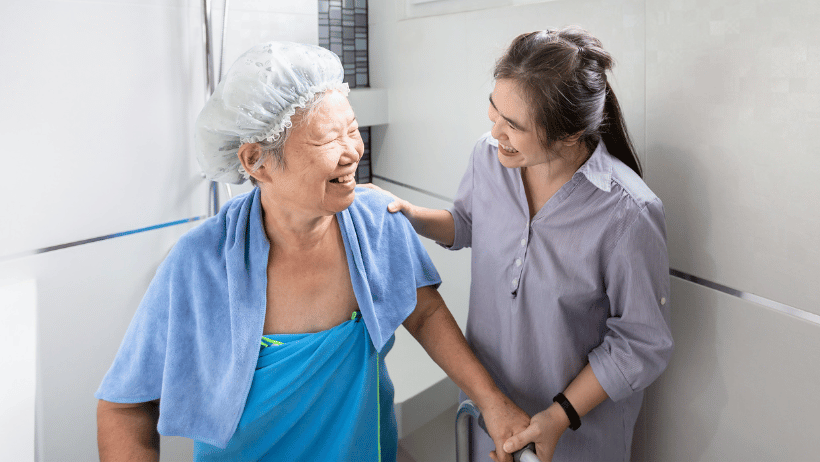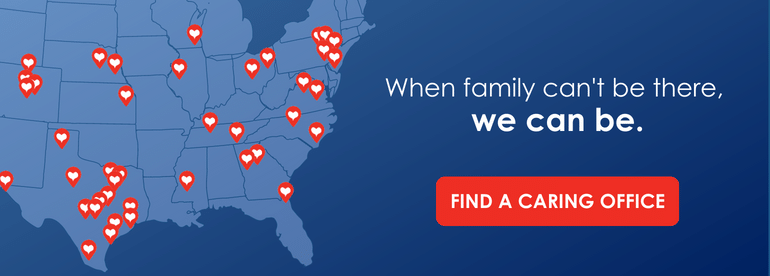As your loved one gets older, they may require help with daily tasks, including showering or bathing. While this is a very intimate task, you can help them remain safe, clean, and fresh. Here are some tips to help a loved one shower in a safe and respectful way.
Preparing for a Shower
Before your loved one gets into the shower, there are a few things to consider.
Get Everything Ready
Before you help your loved one get clean, make sure you have everything that you will need. You don’t want to have to leave your loved one unattended while you run and grab an extra towel or the right bottle of lotion.
Here are some items you may want to have at the ready:
- Gentle soap in a scent your loved one likes
- Shampoo and conditioner
- Wash clothes or sponges
- Towels
- Body lotion
- Shower stool
- Clean change of clothes for your loved one
Check the Room Temperature
No one likes getting out of a warm shower in a cold room. Make sure the bathroom temperature is just right so that your loved one doesn’t get cold when they get in or out of the shower.
Help Your Loved One Get Ready
You may have to help your loved one get ready for the shower by assisting them with undressing. Try to respect their privacy as much as possible, and let them do what they are able, assisting only with the tasks they need help with. You can even give them a robe for privacy, which can also be worn when they get out of the shower and can help with drying off.
Helping with the Shower
As you help your loved one shower, here are some things to keep in mind.
Test the Water
When it’s time to shower, turn on the water and test the temperature against the back of your hand to make sure it’s not too hot or too cold. Not only can hot water be extremely uncomfortable, but it can also lead to dry skin, rashes, and itchiness. Aim for warm water that will be comfortable for your loved one.
Getting into the Shower
Help your loved one remove their robe, if applicable, and get into the shower safely. They may need to hold your hand or a grab bar for stability, especially if they need to step over the side of the tub or sit down on a shower chair.
Washing
At this point, the level of assistance you provide will be determined by your loved one’s abilities. If your loved one is able to wash themselves, then you could close the shower door or curtain and wait until your loved one is done.
If your loved one requires some assistance, however, you can give them a wash cloth or sponge with soap on it. They can wash areas of the body that they can safely reach. Then, you can assist with other areas that may be hard for them to reach on their own, like the feet and back. Help your loved one gently apply shampoo and rinse it out, too.
However, if your loved one requires complete assistance, then we recommend using a wet washcloth with soap on it. Gently rub the wash cloth over their skin. Make sure you cleanse between the folds of the skin and the groin area. Generally, move from the cleanest areas to the dirtiest.
You may also want to consider washing hair separately from the regular shower routine. Sometimes it can be easier and more pleasant to wash hair in a sink, when your loved one can be fully dressed. A handheld shower head may also make it easier for you to help — but it all depends on your loved one’s preferences!
Drying
When your loved one is clean, it’s time to get them out of the shower and dried off. Provide a helping hand to get them out of the shower and onto a non-slip surface. Then, hand them a towel or robe to dry off.
You may need to assist them with drying off areas that are hard to reach. Try not to rub the skin as you dry. Instead, just pat it gently with a towel. This will help avoid irritating the skin.
Skin has a tendency to become dry as we age. So, it’s a good idea to apply lotion after a shower. Just avoid areas that can become naturally moist, like within folds of the skin.
Look for Skin Issues
As you assist your loved one, check for signs of skin irritation. It’s common for seniors to get rashes, sores, or dry patches of skin — especially in bony areas or places where the skin creases. Apply ointment as needed.
Getting Dressed
After your loved one is all dry, it’s time to help them get dressed. Allow your loved one to be as independent as possible. Maybe they can get their arms into their shirt but they need help getting it over their head. Or they might need help with dressing from start to finish.
You may want to direct your loved one from the shower or tub to their bedroom to get dressed, where there is more space and the chance of falling is reduced.
Shower Safety Tips
The bathroom can become quite dangerous, especially when it’s time to shower. Here are some additional safety tips that can help your loved one remain safe and avoid falls.
- Install grab bars to help your loved one stabilize themselves as they get in or out of the shower.
- Put down non-slip mats on the shower floor to help your loved one avoid slipping.
- Keep the floor dry by placing non-slip rugs down or using extra towels to clean up splatters.
- Pick up clutter, like clothes or personal items, to keep the walkways clear.
RELATED CONTENT: Smart Renovations to Make the Bathroom Safer
If your loved one needs assistance with showering and other personal care tasks, we are here to help! Our professional caregivers can help your loved one while empowering them and helping them maintain their dignity. Reach out to your local Caring team today to learn more about personal care.


